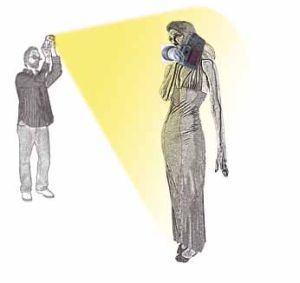articles/Lighting/lightingfordigitalpart16-page3
Lighting for digital Part 16 - part 3 of 1 2 3
by Dave Montizambert Published 01/08/2010

It is funny how things turn out, with this shoot everything seemed to be working against us, but really it was only time we were fighting with, a photoshoot is wrought with an infinite number of variables and so you need time to work through them. In the end I was pretty happy with the results of our efforts, even though it was too dark to get any video footage. I was also amazed at how fast the shoot came together - we managed to pull it off in just seven minutes from arriving at the spot to final click of the shutter - even though at the time it seemed like an eternity with the meter problems and with using the accurate, but cumbersome, white-paper metering method. Also I was really thankful to work with people like Rick who know their stuff and with Sherri who needed little direction, simply tell her an emotion to portray and you were off and clicking.
A few points to wrap up with:
I love the look of out-of-focus backgrounds and foregrounds because of the depth they lend to an image. Shallow depth of field (DoF) is a strong creative tool for creating the illusion of depth (3-D) in flat (2-D) reproduction such as a photo and so for that reason we created the perfect exposure on Sherri by changing the speed-light power settings rather than the camera aperture. Keep in mind that the perfect exposure doesn't have to alter camera aperture - the aperture can stay as is and the exposure can be dialed in by altering the light-source power and/or changing distance of light source and/or, for constant light sources, changing shutter speed.

Hand-holding a light source is fraught with danger - Rick had to concentrate on holding the speed-light in place; if his concentration wandered, the flash would point off the mark and our exposure on Sherri would have suffered.
What really makes the lighting work in this image is placement of the speed-light. If the flash had been left on camera, the shadows would have fallen directly away from the camera creating flat lighting. In my mind lighting should help create the illusion of depth in a photograph, not flatten it out. For this reason I worked with the flash off camera and to one side (see Image [2]); this positioning forced the shadows forward on Sherri. This light direction created a dramatic light pattern over her that portrayed the depth I was after. As for the shadows, some low-level fill lighting at about 3½ stops below the working camera exposure did occur from the overhead sky.
Please Note:
There is more than one page for this Article.
You are currently on page 3
- Lighting for digital Part 16 page 1
- Lighting for digital Part 16 page 2
- Lighting for digital Part 16 page 3
1st Published 01/08/2010
last update 09/12/2022 14:55:51
More Lighting Articles
There are 0 days to get ready for The Society of Photographers Convention and Trade Show at The Novotel London West, Hammersmith ...
which starts on Wednesday 15th January 2025





